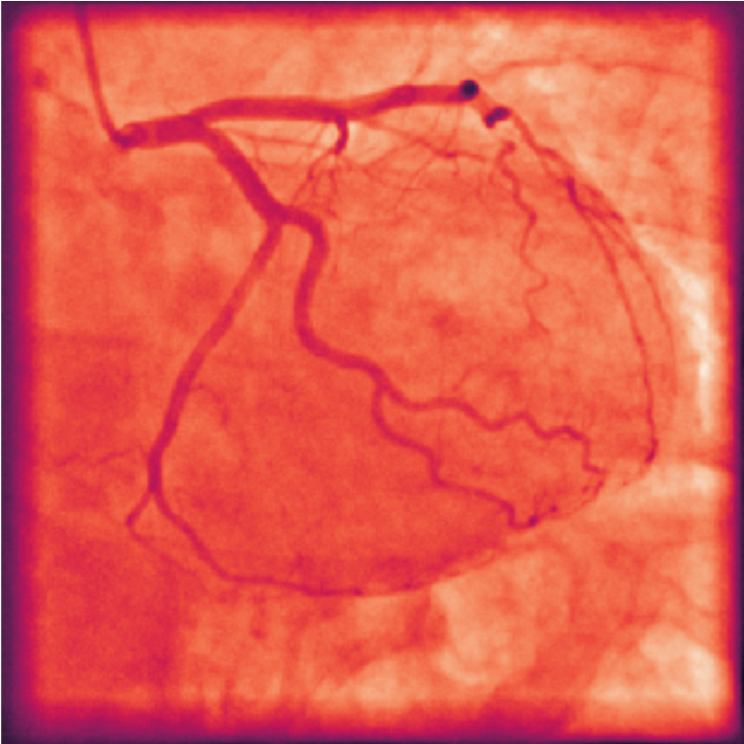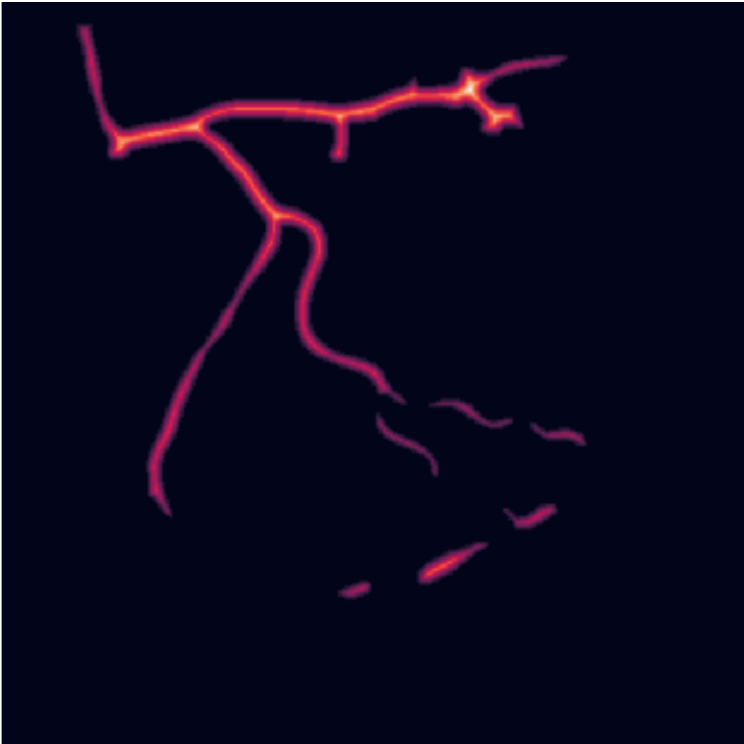News
Finalization of development in the project – CadFlow API Exposure
Autosymed invited to Industrial Panel at IEEE EMBS International Conference on Data Science and Engineering in Healthcare, Medicine & Biology
Presentation at the prestigious IEEE EMBS Data Science International Conference
Seal of Excellence presented to Autosymed
New strategic partnerships
InnovX-BCR Acceleration Phase and Demo Day
Case studies
Research Reproducibility:
Shared datasets enable researchers to validate their algorithms and findings. The availability of standardized data enhances the reproducibility of research, contributing to the credibility and reliability of scientific studies.
Graph generation and identification
of vessel branches
Proper delineation of vessel centerline is crucial for the detection of bifurcation points. By applying a distance transform on the segmentation mask and using an elaborate centerline reconstruction algorithm, we can generate a detailed vessel graph. This graph can be then used to easily identify the vessel bifurcations.
Figure 1: An exemplary image obtained during a coronarography study.
Figure 2: A distance transform applied on the segmentation mask, the location of the centerline is highlighted.
Figure 3: A detailed graph generated from the reconstructed vessel centerline. Vessel bifurcations and endings can be easily detected (highlighted as white dots), directly naming specific vessel
branches according to anatomical interpretation.
Interobserver variability analysis
- reference ground truth
We have investigated the influence of poor imaging conditions on the ground truth determination. The observers’ results vary heavily based on the contrast of the vessels compared with their backgrounds. Some observers tend to be more conservative, others select more pixels just to be safe. Analyzing this interobserver variability is crucial to obtain a trustworthy ground truth. Different MDs were involved in data analysis to provide necessary freedom boundaries for model training (interobserver variability). Three experts were asked to perform manual segmentations independently, and as expected their results varied significantly. Embedding this information as a probability map provides additional information to the training process, reducing overfitting and increasing the flexibility of the model.
Figure 1 and Figure 2: These images show the ambiguity in ground truth determination by three independent experts. The green areas indicate that all observers agreed on the vessel location, in the orange areas only two experts agreed and only one observer selected the pixels marked in red.
Figure 3: The number of vessel pixels selected by the observers. The dotted line indicates the average number of pixels selected per observer. We can see the significant differences in ground truth determination.
CadFlow efficiency and market impact improvements
Finished

Project duration: 1.12.2023 – 19.04.2024
Total grant approved: EUR 122.800,00
Total eligible expenses: EUR 145.000,00
Support upon a restricted call to enhance system robustness, IP and patent application placement analysis, insights into marketing strategy, and legal advice for product localization in different markets.


CadFlow - A novel AI system for computer-aided detection and identification of cardiovascular stenosis
Finished

Project duration: 1.06.2022 – 31.05.2023
Total grant approved: EUR 198.305,00
Total eligible expenses: EUR 233.300,00
The project “A novel AI system for computer-aided detection and identification of cardiovascular stenosis” fuses advanced AI algorithms with medical expertise to leverage cardiovascular healthcare. Developed through a collaboration between a multidisciplinary team of cardiothoracic surgeons, cardiologists, scientists, software engineers, AI/ML, and data experts, CadFlow aims to support the diagnosis of coronary artery disease and personalized optimal treatment indication.


Project outcomes include:
Algorithm Design and Development:
Custom-developed algorithms for assessment automatization of coronarography image data and SyntaxScore calculation, involving coronary artery segmentation, branch identification, stenosis detection, characterization, and scoring their contribution to SyntaxScore.
RichUI Development: The RichUI application, securely deployed in the Azure cloud, allows medical experts to verify, modify, and enhance each AI-generated result to provide transparency, trust, and clinical relevance.
Cloud Deployment:
The application was designed with modern microservice architecture to facilitate efficient AI processing and DICOM data management, as well as to provide scalability and flexibility for further development. It also utilizes external services for base functionalities like user management, data storage, backups, etc.
DICOM Dataset Acquisition and Curation:
A comprehensive DICOM dataset was acquired, analyzed, curated, and cleaned for algorithm development and evaluation.
Feedback from Medical Experts:
Through RichUI real-time feedback on algorithms results has been collected from medical experts and utilized to refine the AI model to ensure clinical compliance and viability.
Throughout the project, milestones have been accomplished, the project results have been disseminated through international conferences and peer-reviewed publications, and collaboration with the medical community has been strengthened. CadFlow paves the way for enhanced cardiac care, combining AI capabilities with clinical expertise for improved patient outcomes and informed treatment strategies.
Cadflow API Exposure – AI based Computer Aided Medical System Capabilities Exposure with API Service
Finished



Project no.: 2022/347151
Total grant approved: EUR 234.700,00
Total eligible expenses: EUR 199.495,00
Project duration: 1.04.2023 – 31.03.2024
The project aims to extend CadFlow by developing capabilities related to computer-aided personalized treatments, integration with external databases, services for ground truth data acquisition, subscription management, and extending the user interface to support a variety of customer types. Another aim of this project is to further develop and refine AI algorithms for SynstaxScore calculation as well as perform a beta test, final validation, and release.
This innovation will empower medical professionals, researchers, AI engineers, and hospitals to collaborate effectively, ultimately improving the accuracy and quality of CVD diagnosis and treatment.
Research papers
Automated stenosis detection in coronarography image data

Authors
M. Haltiuk, M. Czyjt, W. Ciężobka, W. Serwatka, J. Gałkowski, M. Jarzab, K. Sterna, K. Heryan
Publication:
IEEE EMBS Special topic on Data Science and Engineering in Healthcare, Medicine and Biology
Year: 2023
Abstract:
Clinical relevance: The proposed method aims at the automation of CAD – a world-leading cause of death – diagnosis and personalized treatment suggestions. AI-supported detection and characterization facilitates cardiologist work required for manual data analysis.
A novel framework for differentiating
vessel-like objects in coronarography images

Authors
Witold Serwatka, Katarzyna Heryan, Joanna Sorysz,
Marcin Jarzab, Kamil Sterna
Publication:
45st annual international conference of the IEEE Engineering in Medicine and Biology Society (EMBC)
Year: 2023
Abstract: Coronary Artery Disease is the leading cause of death worldwide. Its prevalence will grow while access to specialized medical care will be further limited due to staff shortages. Therefore, any facilitation of diagnosis or treatment is of paramount importance. The diagnosis based on Coronary Angiography can be automated to perform a quantitative evaluation of lesions. This requires precise segmentation of coronary arteries. At the moment, the state-of-the-art algorithms fail to eliminate vessel-like artifacts that are wrongly included in segmentation results (e.g. catheters, stitches). This is a bottleneck for the automatization of the diagnosis workflow that precedes clinical action. In this paper, we propose a 2-step post-segmentation refinement algorithm.
A binary segmentation of the coronary arteries is used to extract image features – inputs for an XGBoost Classifier. Its predictions are improved by a neighborhood filter that leverages contextual information to assign correct labels. The algorithm is primarily concerned with differentiating vessels from other vessel-like objects and does so with a 99% accuracy rate. It takes advantage of an original local description of Tamura features, which proved to be one of the most influential factors in decision-making. As a result, the segmentation of coronary arteries is cleaned from artifacts, enabling AI-supported diagnosis workflows to be automated.
After re-training, the proposed method can be used to eliminate post-segmentation artifacts in other medical domains.
Conferences
December 2023
Presentation at IEEE EMBS Data Science in Malta
7-9 December 2023 Katarzyna Heryan and Witold Serwatka presented our poster entitled Automated Stenosis Detection in Coronarography Image Data at IEEE EMBS Data Science and Engineering in Healthcare, Medicine and Biology in Malta.

September 2023
Presentation at IEEE EMBC Conference in Sydney, Australia
25 July 2023 Witold Serwatka presented our paper entitled A novel framework for differentiating vessel-like objects in coronarography images: IEEE EMBC Conference: 45th Annual International Conference of the IEEE Engineering in Medicine and Biology Society, Sydney, Australia panel: Biomedical Imaging and Image Processing

November 2022
Participation in Hungary Cardiological Event 2022, CadFlow presentation
Our presence at Hungarian Cardiological Convent 17-19 November 2022 was a meaningful experience. We aimed to foster relationships and broaden our network, particularly through engaging with the Polish Investment and Trade Agency (PAIH).
During the event, we had the opportunity to present our CadFlow ideas to medical experts and showcase our TeleDICOM solution through practical use-cases. Our engagement with PAIH aimed to establish a supportive network for promoting our solutions globally,
benefiting from their focus on Polish-origin businesses.
Additionally, we forged connections with sales representatives specialized in medical product distribution. Our participation in Hungary Cardiological 2022 facilitated valuable interactions, expanded our network, and contributed to the promotion and potential growth of our offerings within the cardiology field.


















